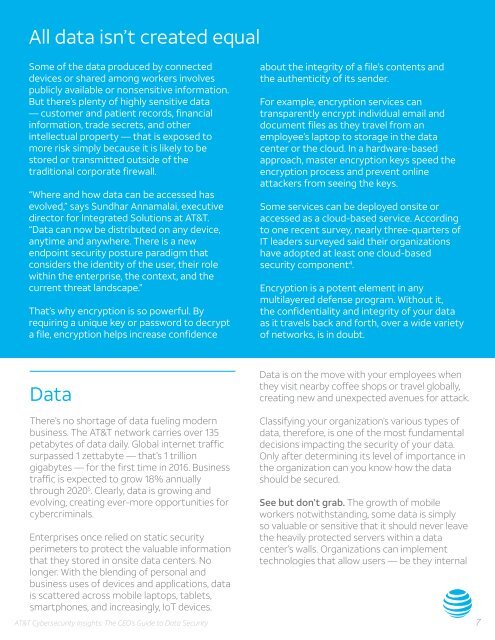The CEO’s Guide to Data Security
2mRmvHx
2mRmvHx
Create successful ePaper yourself
Turn your PDF publications into a flip-book with our unique Google optimized e-Paper software.
All data isn’t created equal<br />
Some of the data produced by connected<br />
devices or shared among workers involves<br />
publicly available or nonsensitive information.<br />
But there’s plenty of highly sensitive data<br />
— cus<strong>to</strong>mer and patient records, financial<br />
information, trade secrets, and other<br />
intellectual property — that is exposed <strong>to</strong><br />
more risk simply because it is likely <strong>to</strong> be<br />
s<strong>to</strong>red or transmitted outside of the<br />
traditional corporate firewall.<br />
“Where and how data can be accessed has<br />
evolved,” says Sundhar Annamalai, executive<br />
direc<strong>to</strong>r for Integrated Solutions at AT&T.<br />
“<strong>Data</strong> can now be distributed on any device,<br />
anytime and anywhere. <strong>The</strong>re is a new<br />
endpoint security posture paradigm that<br />
considers the identity of the user, their role<br />
within the enterprise, the context, and the<br />
current threat landscape.”<br />
That’s why encryption is so powerful. By<br />
requiring a unique key or password <strong>to</strong> decrypt<br />
a file, encryption helps increase confidence<br />
about the integrity of a file’s contents and<br />
the authenticity of its sender.<br />
For example, encryption services can<br />
transparently encrypt individual email and<br />
document files as they travel from an<br />
employee’s lap<strong>to</strong>p <strong>to</strong> s<strong>to</strong>rage in the data<br />
center or the cloud. In a hardware-based<br />
approach, master encryption keys speed the<br />
encryption process and prevent online<br />
attackers from seeing the keys.<br />
Some services can be deployed onsite or<br />
accessed as a cloud-based service. According<br />
<strong>to</strong> one recent survey, nearly three-quarters of<br />
IT leaders surveyed said their organizations<br />
have adopted at least one cloud-based<br />
security component 4 .<br />
Encryption is a potent element in any<br />
multilayered defense program. Without it,<br />
the confidentiality and integrity of your data<br />
as it travels back and forth, over a wide variety<br />
of networks, is in doubt.<br />
<strong>Data</strong><br />
<strong>Data</strong> is on the move with your employees when<br />
they visit nearby coffee shops or travel globally,<br />
creating new and unexpected avenues for attack.<br />
<strong>The</strong>re’s no shortage of data fueling modern<br />
business. <strong>The</strong> AT&T network carries over 135<br />
petabytes of data daily. Global internet traffic<br />
surpassed 1 zettabyte — that’s 1 trillion<br />
gigabytes — for the first time in 2016. Business<br />
traffic is expected <strong>to</strong> grow 18% annually<br />
through 2020 5 . Clearly, data is growing and<br />
evolving, creating ever-more opportunities for<br />
cybercriminals.<br />
Enterprises once relied on static security<br />
perimeters <strong>to</strong> protect the valuable information<br />
that they s<strong>to</strong>red in onsite data centers. No<br />
longer. With the blending of personal and<br />
business uses of devices and applications, data<br />
is scattered across mobile lap<strong>to</strong>ps, tablets,<br />
smartphones, and increasingly, IoT devices.<br />
Classifying your organization’s various types of<br />
data, therefore, is one of the most fundamental<br />
decisions impacting the security of your data.<br />
Only after determining its level of importance in<br />
the organization can you know how the data<br />
should be secured.<br />
See but don’t grab. <strong>The</strong> growth of mobile<br />
workers notwithstanding, some data is simply<br />
so valuable or sensitive that it should never leave<br />
the heavily protected servers within a data<br />
center’s walls. Organizations can implement<br />
technologies that allow users — be they internal<br />
AT&T Cybersecurity Insights: <strong>The</strong> <strong>CEO’s</strong> <strong>Guide</strong> <strong>to</strong> <strong>Data</strong> <strong>Security</strong> 7



